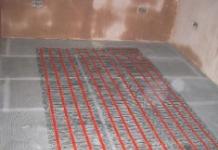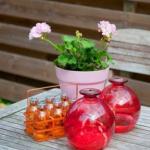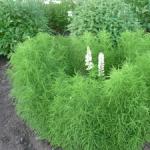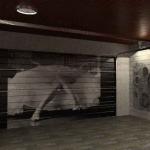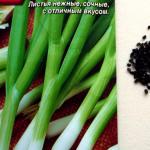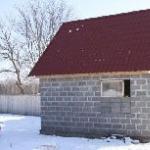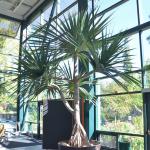During the construction of a combined house, the lower floor is made using stone, and the upper one is constructed from wood. Such a design makes it possible to fully realize all the positive aspects of the selected materials and avoid the appearance of their negative features.
Service life
The stone is used due to the fact that it is very durable, has a long service life, does not rot, and also does not begin to deteriorate from the influence of water and moisture. It is worth noting that many people are often not comfortable in stone buildings. Moving from an apartment outside the city, I want to feel more comfort. It is a little more difficult to heat a stone building than a wooden one, but the reliability of the structure fully compensates for this shortcoming.
The tree, in turn, has a positive effect on the atmosphere inside, making the cottage more comfortable and warm, and also perfectly regulates the humidity in the room. A wooden house creates a more emotional and personal feeling of a home than typical high-rise buildings with neighbors from all sides. Some people are intimidated by the fact that wood is a great burning material, and is also afraid of exposure to moisture, fungi, small rodents or termites, but with modern technology, all these problems have long been solved.
Houses made of stone and wood perfectly combine such an original base and upper floors, which makes it possible to eliminate two birds with one stone, dividing the functionality of wood and stone in such a way as to get the advantages of each material. Such a structure also has a very non-standard, stylish and original appearance, which its owners will not fail to like.
Where to put wooden structures, and where brick
You need to build an inexpensive combined house correctly. The first floor of the building is made using brickwork. The most effective and successful solution would be the arrangement of insulation with the method of a ventilated facade. Aerated concrete blocks can also be used. Thus, on the first floor it is worth installing the most “flammable” rooms, such as a kitchen, a hall with a fireplace, a sauna, and a place for cars.
The attic floor is being built using wood. Most often, logs, glued or profiled timber, unplaned timber with finishing and insulation are used. From above, the wood is securely covered by large roof awnings, and it is a whole floor away from the damp earth. Thanks to special protective coatings, such wood can last a very long time without spoiling or aging. Therefore, on this floor, with greater comfort and better ecology, it is worth placing living quarters.
With great responsibility, it is necessary to approach the choice of decoration inside the house, so that the stone and wooden parts of the house blend harmoniously with each other. However, you should not create a monotonous interior, it is better to emphasize the advantages of each of the materials. Such buildings inside are equipped in the “country” style, which will effectively emphasize the advantages of materials, as well as natural forms.
How to build a combined house inexpensively
The price of building a house depends on:
- materials that you decide to choose for construction;
- your design requirements;
- site location;
- building area.
By choosing high-quality and reliable performers, you can build a real dream cottage!
A combined country house is always an attractive building that has been popular for many years. For the first time, such buildings began to appear in the Middle Ages in the Alps, they were erected by shepherds during wintering. Gradually, they began to gain popularity throughout Europe, until they reached our country. The "chalet" style allows designers to show all their creativity and imagination. For example, the upper floor can be decorated in a medieval style.
Prices for the construction of combined houses in the company "Vitoslavitsa"
In our company, the prices for turnkey combined houses are very affordable for everyone. We can carry out both standard options, prepared in advance by our specialists, and the construction of houses according to private drawings, which will be developed in strict accordance with your wishes.
The Vitoslavitsa company builds country houses in the best Russian traditions, improving its professionalism and introducing new engineering solutions and creative ideas into each subsequent project. If you want to order the construction of a combined house in Moscow, then perhaps it's time to turn your desire into reality by contacting us.
We can bring to your attention standard combined buildings or implement an individual project of a turnkey house.
Advantages of combined houses
A combined house is a harmonious symbiosis of the solidity and aristocracy of stone with the natural warmth of wood, which provides the exterior of the housing with a wonderful appearance, and the interior with an inimitable atmosphere saturated with coziness and comfort. However, this is not all, with which these buildings have earned an excellent reputation and secured wide popularity.
The main advantages of such houses include the following:
- Saving. From brick (sometimes from clay adobe, river shell rock or cinder blocks), only the first floor is built, and the second is made of wood. Such an architectural solution provides a relatively low weight of the structure and, as a result, no need for a very expensive foundation. Moreover, the cost of building a second floor also using stone is usually much higher than the cost of using wood materials.
- High fire safety. Obviously, wood is a combustible material, but the construction of the first floor, where the kitchen, fireplace, boiler room is usually located, from stone significantly reduces the risk of fire, and if necessary, it simplifies the localization of the hearth.
- Durability. The brick has an extremely high resistance to destruction under the influence of moisture and is characterized by mechanical strength. In turn, timber and wood composites manufactured at Vitoslavitsa are also highly resistant to negative environmental influences and mechanical stress, but reducing the frequency and intensity of such impacts only increases the service life of the house.
- All season comfort. Combined houses made of stone and wood retain heat well. At the same time, the latter material contributes to the stabilization of indoor humidity, thanks to which a comfortable microclimate is achieved in the premises.
Construction stages
If you do not take into account the development of the project, then the construction of any capital building begins precisely with the construction of the foundation. In this case, the best options are recessed tape and slab.
- The beginning of the construction of walls made of stone (as mentioned above, materials such as brick, clay adobe, river shell rock, cinder block can be used);
- Installation of floor coverings;
- Completion of the construction of stone walls;
- Installation of wall coverings;
- Assembling the second floor (using a rounded log, glued or profiled timber);
- Installation of the supporting structure of the roof;
- Arrangement of thermal, steam and waterproofing, as well as installation of roof ventilation;
- Roofing;
- Summing up engineering networks and systems;
- Exterior and interior decoration of the house.
Advantages of ordering combined houses from Vitoslavitsa
- A rich selection of beautiful houses: we can implement both the projects of combined houses presented on our website, and develop an exclusive solution for you.
- Having our own production: this allows us not only to guarantee the quality of the materials used, but also to provide you with the maximum benefit from cooperation with us.
- Impeccable reputation: for more than 5 years Vitoslavitsa has been building private houses, and during this time we have made more than 150 customers satisfied.
The combination of materials is a favorite pastime of designers; in capital construction it is used to solve important practical problems. A competent combination of the physical qualities of stone and wood in the load-bearing walls of the building gives the developer a tangible gain in cost and comfort.
It is these two factors that have made houses made of combined materials popular and widespread in modern suburban construction.
What combinations are reasonable and permissible in the construction of such a structure?
Most often, stone is chosen for the walls of the first floor (brick, monolithic concrete, aerated concrete or expanded clay blocks). The second floor is built from round logs or glued beams.
It should be noted that combinations of different wall materials can also affect the exterior finish. A combined house allows you to use any options for facade decoration: the brick walls of the first floor can be finished with a blockhouse, insulated using the “ventilated facade” technology.
The second frame floor can be ennobled with decorative plaster or stone tiles. As an example, we suggest you consider the photo below.

Looking at such a house, you will not be able to unequivocally answer the question of what its load-bearing walls are built from. Although the combined technology of building walls is also used here. The first floor of this building is brick, lined with siding. The second is a wooden frame finished with ceramic tiles.
Constructive options for combined houses
Despite the variety of facade decor, the construction of combined houses must comply with the main principle: 1st floor stone 2nd floor wood. It provides the building with the necessary strength and creates conditions for comfortable living on the second floor. Another problem solved by the combination of materials is to reduce the labor intensity and cost of construction.

Those who do not want to spend extra money on exterior decoration act wisely. The combination of stone and wood is optimal not only from constructive considerations, but also from the standpoint of aesthetics. Therefore, do not hide behind the finish what looks perfect in itself.
An example is a mansion built in a deliberately rough combination of natural stone and logs. It fully complies with the canons of country style.

From the harsh mountainous terrain, it leads its pedigree, invented by alpine shepherds. It also used the idea of combining durable stone and warm wood.
Life in the mountains requires maximum reliability and functionality. Therefore, the first level of the chalet is always built from solid rock, which is not afraid of snow blockages, rockfalls and water. The second floor is designed to create comfort and coziness. For these purposes, there is no better material than natural wood.

The "generic sign" of all buildings built in the chalet style is wide roof overhangs that protect the walls from heavy rains and melting snowdrifts.
Modern combined houses made of stone and wood are extremely diverse, since the choice of wall materials is very wide. If you are not satisfied with a torn stone or a flat limestone "flagstone", then build the first floor from. They are strong enough and at the same time as warm as natural wood.

When preparing for construction, do not forget that houses made of foam blocks and wood require a reliable connection between the first and second floors. Cellular concrete is a rather fragile material. Therefore, it will not hold the steel anchors that fix the second level support beam.

A competent solution for such a design is pouring a monolithic reinforced concrete belt along the foam block walls. It increases the spatial rigidity of the building and allows you to securely fix the anchor bolts.
The appearance of the foam block wall is not very expressive. Therefore, it is better to sew it up with a blockhouse or siding, laying a vapor barrier and a layer of mineral wool insulation behind the facade cladding.
For the combined construction of a cottage, you can use. They are stronger than foam concrete, not so fragile and very warm. Finishing wood concrete walls is not laborious, since any decorative plaster adheres perfectly to them.

The second floor can be built from planed timber. This material retains heat well in a residential floor and does not require finishing cladding.

If you need a three-level combined house of brick and timber, then build it according to the following scheme: the basement technical floor is monolithic reinforced concrete, the first level is brick, the second is a frame or log house.
Speaking about the frame version of the walls of the second floor, we note that it will not only save you money, but also allow you to flexibly change the internal layout, adapting it to family needs.

You can hide the frame of the second floor behind the finish. Another interesting option is to specifically highlight it, turning it into an element of facade decor. Fachwerk is best suited for this - an old frame system in which posts, beams and cross braces open onto the facade.

A serious problem of all cottages is dampness on the first floor. The combined house solves it simply and functionally. The lower floor is reserved for utility rooms. Here you can equip a boiler room, a bathhouse, a workshop and a garage. Bedrooms, bathrooms, dressing rooms, playrooms and a kitchen are located on the second, drier floor.
A combined house and a combined facade are not the same thing!
As we have already said, a combination of different wall materials is the main feature of a combined building. In contrast, the combined facade of the house can be used on any residential building.

For example, having built a cottage from insulated sandwich panels, you can easily “disguise” it as a stone one. To do this, you can use ceramic tiles, sandstone, porcelain stoneware or rustic plaster. If ordinary, rather than face bricks are used for laying walls, then a “combi-facade” will also be appropriate.

The photo shows a house built of brick and timber. Obviously, the nondescript brickwork will need additional finishing. It does not have to be decorated "under the stone." It is enough to fill the blockhouse along the guides and your house will be completely “wooden”. Another option is a combination of semicircular false logs on the first floor and glued beams on the second.

Pros and cons of the combination idea
Having noted the main advantages of combined buildings: efficiency, layout flexibility, aesthetics and functionality, we will point out the disadvantages of such buildings.
The main one is the different time of "life" of stone and wood.. In rocks, it reaches 150 years. The tree, at best, will last half a century. For a light frame and shield walls, this period will be even less. Therefore, the moment will inevitably come when the first stone floor is still quite strong and reliable, and the walls of the second one already require repair.
Since the combined country houses in Russia are still quite young, there is no negative experience of different aging rates of wall materials. Therefore, the reviews of their owners are mostly positive.
Summing up, we advise everyone who has decided to build a combined cottage not to forget about the different service life of the first and second floors. To extend the life of the walls, buy well-dried and antiseptic wood, and trust the assembly of the frame to experienced professionals, not shabashniki.
For a wooden frame, a well-assembled drainage system is required to prevent moisture from entering the tree. In addition, at the construction stage, constant quality control of sealing of all cross sections of wooden posts and beams is required.
A combined house is a building, during the construction of which different materials were used - in load-bearing structures or in decoration. The construction of such cottages for housing has been practiced since ancient times, an example of which is a traditional Scandinavian chalet with a stone ground floor and a wooden attic. The company "The Bronze Horseman" offers modern options for the construction of turnkey combined houses - projects for implementation in suburban areas in Moscow, St. Petersburg and regions of Russia.
Types of combined houses
Each building material has its pros and cons. Stone is strong but heavy, wood is lighter and more human friendly but rots, etc. Building a house from different types of materials aims to make the most of the advantages and minimize the disadvantages of each of them. In modern architecture, combination is also used to give the building a unique appearance, using in the implementation of original design ideas.
Taking into account all types of combinations and their features, 3 types of projects for the combined construction of houses can be distinguished:
- Combining different materials of load-bearing and enclosing structures (for example: the basement and the first floor are made of brick, and the attic floor is based on frame technologies with sheathing with a facing board);
- The so-called "conditionally combined" buildings, in which brick and wood are combined in the performance of the corresponding elements (wooden floors and a truss system for a building made of aerated concrete or brick);
- With a diverse facade finish (plaster and lining, wood and natural stone).
Project selection
Projects of combined houses and cottages in the catalog are placed taking into account the convenience of their selection and comparison. To help site users in this category, 2 filters are installed:
- Highlights projects that have a combination of finishes. With the help of a material of a different texture or color, a chimney placed into the exterior, rustication or individual elements in the form of decorative inserts can be made out.
- Shows a whole series of combined houses (category "European houses" with the exception of the Scandinavian style).
We will help you design housing individually or build a turnkey combined house at the lowest price - only the proposed equipment is included in the cost of work, without additional options and surcharges.
A private, beautiful spacious house, built by oneself, attracts many. But, it's one thing to dream of your own home, and it's completely different to build a building from the foundation to the roof. Today, residential buildings made of stone and wood are very popular.
The chalet style is gaining momentum and becoming a fashionable trend in construction. Designers offer a variety of projects for combined houses related to the elite, middle and economy class. In most cases, future owners of private housing are interested in inexpensive projects of combined houses made of stone and wood.

In addition to the low cost, combined chalet houses made of stone and wood attract with a lot of advantages. Among these, it should be noted:
- Structural durability.
- High level of wear resistance, strength.
- Fire safety.

Plus, wood structures are distinguished by comfort and heat retention. And in combination with brickwork, such a structure looks beautiful, soundly. So that the used materials are not wasted, the masters recommend to think in advance in which version they will be used. The most popular is the project of a combined chalet-style house.

Not good choices
Projects of combined houses are different. Reviews of the masters say that not all of them are successful. For example, the option in which a brick structure is first built, and then lined with wood clapboard, can ultimately lead to damage to materials. Let's not forget that brick and wood have different coefficients of thermal expansion. If the brickwork is veneered with wood correctly, then a sufficient distance must be left between the materials. But over time, insects and rodents can start in this space.

The opposite option is also possible, in which a wooden structure is faced with brick. But from the rearrangement of the sequence of materials used, the essence does not change. Between the layers of materials, mold, fungus, and bark beetles can form.

Best projects
Reviews about turnkey combined stone and wood houses claim that the most optimal combination of materials is floor-by-floor, as shown in the photo. For example, a project of such a structure might look like this:
- The first floor is a brick building with utility rooms - a kitchen, a dining room, a boiler room, a guest room with a fireplace.
- The second floor is wooden. There is a bedroom, a nursery, guest rooms. The gentle aroma of wood will promote relaxation and peace.

Reviews of the masters claim that in order to create an ideal combined house project, it is necessary to take into account the requirements and wishes of the customer. In any case, the master must warn the future owner that it is better to place engineering communications on the ground floor. Considering the lightness of wood, it is not necessary to build the first floor from this material. The supporting walls must be made of stone so that the house as a whole is strong and reliable.

Variations
The combined economy class turnkey stone-wood house can be built from a concrete monolithic foundation, ceramic bricks and pine wood. Since the house is two-story, stairs inside the building are a must.

An excellent choice is wooden stairs inside the house and monolithic stairs outside. A magnificent addition to the building is the attic on the second floor, which has a decorative finish similar in color to the walls of the first floor.

Economy class projects of combined houses made of stone and wood in the style of a chalet must include a spacious terrace. This element of the structure is a distinctive feature of such housing. Another essential element of a successful chalet-style project is the presence of a flat roof with a wide wingspan. Thanks to this solution, the wood part of the structure is protected from moisture and precipitation.

Despite the abundance of modern effective materials, at the moment traditional natural stone and its artificial counterpart do not lose their popularity.
Due to their unsurpassed decorative qualities, they are mainly used in the design of facades and interiors of buildings. This material of any origin is characterized by durability, absolute fire resistance, low maintenance. Its high aesthetic characteristics, variety of shades and textures give architects complete creative freedom, allowing them to create unique pompous ensembles and chamber cottages.
The organic combination of "mosaic" cladding with architecture in the spirit of cubism 
The diversity of facing with decorative stone
Artificial products are extremely widely used at the moment in finishing work, despite the fact that in terms of their physical characteristics they are significantly inferior to natural ones. This is due to the ease of installation of a decorative analogue, the lightness of the cladding elements that do not require a powerful base, low price, a huge variety of textures and a wide range of colors.
Application in the organization of the porch of organic forms

According to the composition and production technology, the following types of artificial products are distinguished:
- concrete cladding is manufactured by vibration compaction of high grade cement slurry. Finishing care - coating with paint and strengthening primer every 2-3 years;
- polymer sand tiles characterized by elasticity, low price and relatively low strength;
- products based on synthetic resins in absolute accuracy repeat the appearance and shades of natural raw materials, the crumb or dust of which is included in the composition;
- porcelain stoneware due to its production from feldspar, fired at more than 1400 ° C, it has high durability and unique strength;
- clinker tiles perfectly imitates stone and brickwork, differing from them in a more democratic cost and low weight. It has good qualities of sound and heat insulation, protects from atmospheric influences;
- flexible cover- sandstone tiles glued with a polymer to a textile base. Differs in durability, elasticity, antistatic properties, small weight and ease of installation on difficult surfaces - columns, cornices, arches.
Cottage in a picturesque area in Cyprus 
Modern cottage 
The warmth and sunshine of artificial veneer

Cozy shelter in the forest 
A house in the USA with an unusual facade trimmed with artificial material impresses with luxury 
Another example of a luxurious facade 
The use of clinker tiles for continuous wall covering on a classic-style cottage

Polymer sand tiles in the design of the mansion 
Exquisite duet - plaster and decorative stone
Free flow of planes of different textures on the facade 
These materials are perfectly combined with each other in the decoration of the house, creating exquisite exteriors. They can be combined, creating planes with clear boundaries or smoothly flowing into each other. For example, the torn edges of the facing of the corners with artificial limestone turn into a plastered surface. In the same way, window and door openings, arches are made out.
On a note! At the moment, a popular solution - stones in the form of chaotic inclusions appear through the plaster.

Fragmentary cladding of a plastered facade with masonry of elements of different sizes

Finishing the plinth with artificial masonry
When using decorative cladding to decorate the lower part of the building, an extremely important point is to reinforce the surface of the walls to strengthen their connection with the finish. Above the plinth, it is necessary to fasten ebbs - it is most susceptible to the negative effects of precipitation. This measure, which is carried out after masonry, before finishing the facade, will protect the foundation from moisture.
Advice! To create a harmonious facade, the plinth material must be in harmony with the color of the roof. The shade of the finishing elements of the bottom of the house must be chosen somewhat darker than the base to which it will be attached.
Finishing the plinth with cobblestone looks spectacular in combination with brickwork 
Original lined plinth cladding with large inserts 
The stone finish of the plinth smoothly flowing into the wall of the facade looks impressive 
Building corner cladding
This design of corners is also called rustication, which is densely spaced rectangles or stripes with pronounced seams between them. They are designed to give the facades sophistication and emphasize the reliability of the structure. If 100 years ago rustication was carried out using complex brickwork, today it is created using modern materials, including tiles of artificial origin. This technique is also often used to decorate window and doorways of houses. Recently, the asymmetric version of rustication and its “torn” outlines have become increasingly popular.
Advice! To achieve the most natural effect of masonry from natural raw materials, it is necessary to choose design elements from different batches, since natural stone does not happen to be the same in color and shape.
Finishing corners and windows with "torn" outlines  Mansion in the mountains of Utah
Mansion in the mountains of Utah

Photo from prestige-mls.com
Extravagant decoration of the corner of the house 
Finishing the facade of the house with stone panels
For the design of buildings, elements can be used that differ in the principle of installation, colors, textures and dimensions. In addition, facade panels with a coating imitating, for example, natural marble, are divided according to the material of manufacture, of which plastic and PVC are the most popular. Their surfaces can copy a wide variety of rocks: granite, limestone, thin slate.
Due to the peculiarities of production technologies, facing elements have high strength and resistance to adverse environmental influences. Front panels are capable to serve for additional warming and sound insulation of the building.
The use of panels in combination with siding to design a cottage with a complex architectural solution 
Panels on the facades of a laconic house emphasize the severity of its forms. 
The dark colors of the panels fit perfectly into the forest landscape.  Light finish effectively contrasts with the dark tiled roof
Light finish effectively contrasts with the dark tiled roof 
Houses with rock-look siding
This type of facade finish can have various coating options: metal, resins, cement-sand compositions, various polymers. The similarity of the surface with natural stone is achieved by adding fine crumbs of malachite, marble, and other rocks to the molding mass. Another way is to cover with an artificial product from a cement-sand mixture, resins and coloring pigments.
On a note! At the moment, the most popular siding that imitates the surface of a wild stone. High similarity is achieved through the production of products by casting from propylene using templates from natural cobblestones.
A house sheathed with stone-like siding in two colors - a contrasting and original solution

Siding Nailite on the facade of the cottage 
The facade and plinth are decorated with siding with different textures.  Realistic rock texture on siding
Realistic rock texture on siding 
Sheathing of buildings with "stone" profiled sheet
A stable pattern of imitation of natural rocks on a profiled sheet is created through the use of offset printing and multi-purpose painting, which allows creating any texture due to a combination of 4 primary colors. The profiled sheet coating is resistant to mechanical and atmospheric influences.
A house sheathed with a profiled sheet under a stone in combination with elements imitating wood  Profiled sheet imitating masonry
Profiled sheet imitating masonry  The facade of a profiled sheet with a "stone" texture looks spectacular with a metal fence
The facade of a profiled sheet with a "stone" texture looks spectacular with a metal fence

Spectacular natural stone houses
The nature of the facing of buildings with natural rocks depends on the architectural design of the facades. Finishing can be solid or partial, from polished or "wild" slabs. It can be made of stone slabs of the same breed or in a combined version. Competently selected and laid in compliance with the technology, finishing elements from natural raw materials require minimal maintenance during operation.
Advice! With various methods of laying the slabs, the combined cladding with inserts of decorative fragments looks most impressive.
Advantages of finishing with natural material over artificial counterparts:
- extremely neat and respectable appearance;
- the longest service life and extremely high resistance to mechanical damage;
- the ability to maintain their qualities under the influence of temperature changes, humidity and sunlight;
- lack of tendency to deformation and cracking;
- reliable fire protection;
- originality of natural textures and shades;
- no need to treat the material against mold and corrosion, which can significantly reduce operating costs.
Modern complex - architecture looks organic in the forest landscape

Reconstruction of a barn built in the 15th century 
Vacation Home, Big Sky, Montana 
Sophisticated luxury of a country house in Utah 
Very beautiful stone houses in Idaho 
Torispardon cottage project in Scotland

The idea of a house in a modern style from the design workshop "Architect4U" 
Features of finishing with wild stone
The breed is resistant to various atmospheric influences, retaining its originality for an extremely long time. It is most often used for facing the plinth, corners, door and window openings.
Wild breeds of natural origin include:
- ragged sandstone, usually laid in a chaotic manner;
- boulders - fragments treated with water. They can have lake, sea, river and glacial origin. The most valuable are boulders 15-35 cm in size;
- sea pebble - the remains of rocks, having a flat and even shape;
- meotis (shell but) has a structure with long fibers and properties similar to ceramics.
Important! At the moment, imitation of "wild" stone slabs is also made artificially. Such products have an extremely rich color range and a wide range of textures.
Facing with a bizarre pattern of torn sandstone contrasts favorably with the blue roof 
Harmonious combination of cladding with light siding 
Caucasian stone- this is, in fact, one of the varieties of the wild. It mainly includes quartz, sandstone, granite. Due to their original shapes, smooth surface and gray, light and blue shades, they are actively used to decorate facades and areas adjacent to the house.
Photo of a house whose facades are finished with Caucasian rock with a characteristic bluish tint 
Dagestan stone cladding
The rock mined on the Caspian coast can have more than 80 varieties of textures and more than a hundred shades from white to burgundy and dark gray. The surface is polished, chipped, polished, sawn. Limestone, dolomite and sandstone are mainly used for facades.
Facing a luxurious house with a triple arch at the entrance creates associations with Antiquity 
Luxurious facade lined with material from Dagestan deposits

Important! Having a red-yellow hue, the Rugel stone is a variety of Dagestan stone and is close in structure to shell rock.
Photos of houses lined with rukel rock create a feeling of glowing buildings from the inside

Booth in home decoration
Booth is a combined concept, which includes sandstone, dolomite, and limestone, which have only common parameters: weight should not exceed 50 kg, and size - 500 mm. In its composition, impurities of marls and clay are unacceptable. Booth cannot have cracks and delaminations.
Houses with masonry walls with the inclusion of rubble stone give the impression of reliability and security, like a real fortress 
An extension to the house in the form of a tower made of buta evokes thoughts of fairy tales

Burlatsky stone
This definition is not of any specific rock, but of stone products that are shaped like a bar. As a rule, shell rock is used for their manufacture.
The photo emphasizes that the house made of burlak material is emphatically restrained and strict.

The severity of masonry made of burlak material can be facilitated by openwork fences and details 
Combined houses made of stone and wood
The combination of wood and stone materials is a rational and cost-effective solution:
- lightening the total weight of the structures makes it possible to abandon the construction of a massive foundation;
- fire-resistant stone materials for the first floor, where a living room with a fireplace, a furnace, a garage, a bathhouse can be located - the best option;
- wood is a natural insulation, which makes it possible to save on thermal insulation;
- the first floor of non-rotting stone materials increases the durability of the building;
- reduction of terms from the beginning of construction to settlement - while the process of wood shrinkage is in progress, the first stone floor can already be finished and settled;
- stone-wooden houses provide great opportunities for the implementation of architectural ideas.
In a cottage located on a slope, the lower stone part, on the one hand, structurally plays the role 
Chalet-type house, designed and implemented by the design workshop "Architect4U" 
Combined house, where the material of a part of the building exactly corresponds to its function. Stone elements perform a supporting function, wooden elements - enclosing 
The combination of different material elements creates an original and at the same time cozy image. 
Popular material combination in Europe 
House-mountain - a pitched roof with protruding wooden elements rests on rubble masonry 
House: first floor - stone, second - wooden
Structurally and economically, the most justified option is to use stone materials in combined cottages for the lower tier, and build the upper one from wood. This technologically simplifies the construction process and makes it possible to evenly distribute the load on the foundation.
Advice! For additional weight reduction for the construction of the second floor, it is better to use not rounded logs or timber, but frame technology.
Photo of a cubist house combining traditional materials uncharacteristic of this style 
The dark tones of stone and wood blend seamlessly into the surrounding forest. 
Stone is a versatile material with the highest strength, durability, and fire resistance. At the same time, it fits perfectly into any architectural style. It harmonizes perfectly with all existing materials, from wood to chromed metal.
All projects of beautiful stone houses in the photo have a different degree of complexity of implementation, so it is advisable to trust these works to professionals - a number of works with stone require special knowledge and qualifications, the use of specific technologies.
Video selection of photos of natural stone houses
Probably, in 50 years, the houses shown in the video will be perceived as we perceive the houses of the classical style today, but today they are modern options that delight the eye with novelty and an unusual approach to the implementation of natural well-known material.

